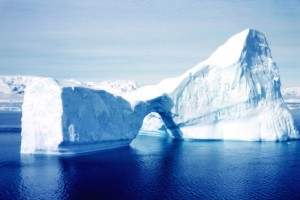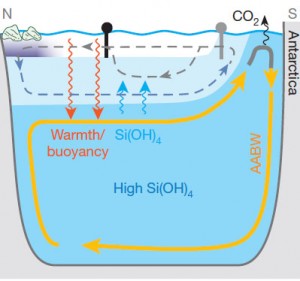by Catherine Zandonella, Office of the Dean for Research

A study of sediment cores collected from the deep ocean supports a new explanation for how glacier melting at the end of the ice ages led to the release of carbon dioxide from the ocean.
The study published in Nature suggests that melting glaciers in the northern hemisphere caused a disruption of deep ocean currents, leading to the release of trapped carbon dioxide from the Southern Ocean around Antarctica.
Understanding what happened when previous glaciers melted could help climate researchers make accurate predictions about future global temperature increases and their effects on the planet.
The evidence is strong that ice ages are driven by periodic changes in the amount of sunlight reaching the poles due to cyclic changes in Earth’s rotation and orbit. Yet scientists have been puzzled by evidence that although the timing of ice ages are best explained by changes in sunlight in the northern part of the globe, the warming at the end of ice ages occurred first in the southern hemisphere, with a rise in carbon dioxide levels appearing to be cued from the south.
The new study suggests that changes in ocean currents, connecting the north to the south through the deep ocean, were to blame.

Part of this story was suggested more than a decade ago and is already accepted by many climate scientists: As glaciers in the north started melting, the influx of fresh water diluted the salty waters that today flow to the north from the tropics as an extension of the Gulf Stream. Normally, these salty waters become cool and sink into the deep ocean, forming cold and dense water that flows southward, and allowing more salty tropical water to take its place in a sort of ocean conveyor belt. But the influx of fresh water due to melting glaciers stalled the conveyor belt.
So how did this lead to changes in the southern hemisphere?
The new research suggests that the shutdown in northern sinking water allowed southern-sourced water to fill up the deep Atlantic, setting up a new ocean circulation pattern. This new circulation pattern brought deep-sea water, which was rich in carbon dioxide due to sunken dead marine algae, to the surface near Antarctica, where the gas escaped into the atmosphere and acted to drive global warming. (See diagram.)
The researchers included investigators from ETH Zürich, Princeton University, the University of Miami, the University of British Columbia, and the University of Bremen and the Alfred Wegener Institute in Germany. The Princeton effort was led by Daniel Sigman, the Dusenbury Professor of Geological and Geophysical Sciences.
The team tracked these historic movements of water through the study of sediment cores that are rich in silicon dioxide, or opal. Tiny marine algae known as diatoms make their cell walls out of opal, and when the organisms die, their opal remains sink to the deep sea bed.
The researchers looked at opal in sediment core samples drilled from deep beneath the ocean floor off the coast of northwest Africa and Antarctica. The team found that each period of glacier melting, which occurred five times over the last 550 thousand years, corresponded to a spike in the amount of the opal in the sediment, signaling an increase in diatom growth. The timing of the opal spikes provides evidence that the deep, opal-rich waters in the south were drawn to the surface in response to new meltwater entering the northern ocean.
The mechanism clashes with a previously offered explanation of why the melting of the northern glaciers, or deglaciations, leads to the release of ocean carbon dioxide from the Southern Ocean – the theory that the melting glaciers in the north increased southern hemisphere westerly winds, which in turn caused upwelling of Southern Ocean deep waters. “While distinguishing between these alternatives is important,” says Sigman, “the greater challenge is to test and understand a premise that is shared by both of these scenarios: that ice age conditions around Antarctica caused the deep ocean to be sluggish and rich in carbon dioxide. If this was really how the ice age ocean operated, then it calls for us to reconsider how we expect deep ocean circulation to respond to modern global warming.”
A. N. Meckler, D. M. Sigman, K. A. Gibson, R. François, A. Martínez-García, S. L. Jaccard, U. Röhl, L. C. Peterson, R. Tiedemann & G. H. Haug. 2013. Deglacial pulses of deep-ocean silicate into the subtropical North Atlantic Ocean. Nature 495 (7442), 495-498. doi:10.1038/nature12006. Published online 27 March, 2013.
This research used samples provided by the ODP, which is sponsored by the US National Science Foundation (NSF) and participating countries under the management of the Joint Oceanographic Institutions. XRF data were acquired at the XRF Core Scanner Lab at MARUM – Center for Marine Environmental Sciences, University of Bremen, with support from the DFG-Leibniz Center for Surface Process and Climate Studies at the University of Potsdam. Further support was provided by the US NSF through grant OCE-1060947 to D.M.S. and by NSERC and CFCAS to R.F.

You must be logged in to post a comment.